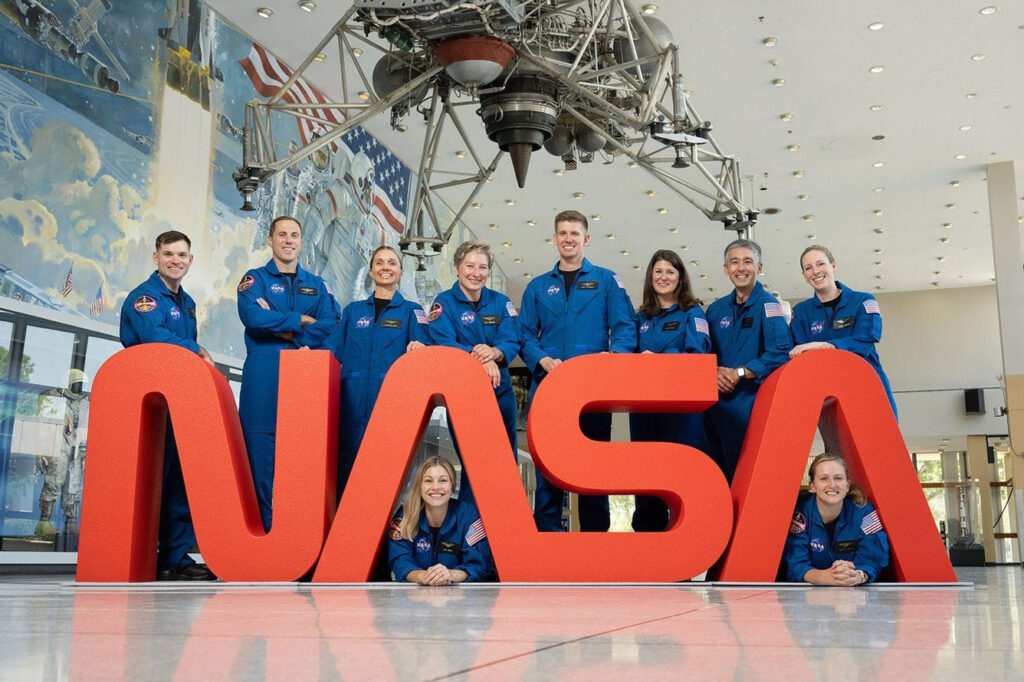NASA has announced its newest group of astronaut candidates—ten individuals who may one day travel beyond Earth’s atmosphere to the International Space Station, the Moon, and perhaps even Mars. While every astronaut class is met with anticipation, this year’s announcement carries an especially historic note: for the first time in the agency’s 66-year history, women make up the majority.
Six women and four men compose the 2025 astronaut candidate class, selected from a pool of more than 12,000 applicants. Among them are military pilots, engineers, medical doctors, scientists, and even a former professional Ultimate Frisbee player. The diversity of expertise underscores NASA’s expanding definition of what makes an astronaut, and the historic gender balance signals a step toward greater inclusivity in the field of space exploration.
As these ten candidates embark on their two-year training journey, they join a legacy stretching back to the Mercury Seven, the pioneering astronauts who defined America’s first forays into space. Yet this new class will be preparing not just to orbit Earth, but to extend humanity’s reach to the lunar surface under the Artemis program—and perhaps beyond.
Breaking Barriers: Women as the New Majority
For decades, NASA’s astronaut corps was a reflection of broader societal barriers: white, male, and predominantly military test pilots. The first American astronauts, announced in 1959, were all men. It wasn’t until 1978 that NASA selected its first female astronauts, including Sally Ride, who would later become the first American woman in space in 1983.
Fast forward to today, and the announcement that women make up six of the ten newest candidates marks a transformative moment. This milestone reflects both societal change and the increasing recognition that diversity in background, gender, and skill set strengthens the astronaut corps.
It also sends a powerful message to the next generation. Young women and girls watching the Artemis program unfold are seeing that not only can they dream of space, but they can realistically expect to be among those chosen to explore it. Representation matters, and NASA’s newest class embodies that truth.
Who They Are: The New Faces of Exploration
The ten candidates bring an eclectic mix of backgrounds to the table:
-
Military Aviators: As in past classes, some candidates come from the armed forces, bringing with them experience in high-pressure aviation and operations. They will be tasked with learning to fly the T-38 supersonic jet, a rite of passage for NASA astronauts that reinforces teamwork and precision under stress.
-
Scientists and Engineers: This class includes individuals trained in fields such as geology, astrophysics, and bioengineering. Their expertise will be crucial for Artemis missions, where scientific research on the lunar surface will be a central objective.
-
Medical Experts: Astronauts with medical training are increasingly important as NASA contemplates longer missions, including trips to Mars. Medical doctors among the class will play vital roles in ensuring the health of crews in deep space.
-
Unique Backgrounds: One candidate stands out as a former professional Ultimate Frisbee player, reflecting how NASA values not just technical skills but teamwork, adaptability, and leadership qualities developed outside traditional scientific or military paths.
This diversity of talent reflects a broader shift in NASA’s recruitment strategy. Astronauts are no longer narrowly defined as elite test pilots or engineers. Instead, they are multidisciplinary problem-solvers capable of thriving in extreme environments, embodying resilience, intellect, and creativity.
The Artemis Program: A New Horizon
The timing of this astronaut class is no accident. NASA’s Artemis program aims to land the first woman and the next man on the Moon, establishing a sustainable human presence there by the end of the decade. Some of the candidates in this new class may well find themselves walking on the lunar surface in just a few years.
Artemis represents more than a return to the Moon—it is a bridge to Mars. The program will test technologies for long-duration exploration, including habitats, life-support systems, and surface mobility. The Moon is not the destination but the proving ground, and this class of astronauts may be the first to take humanity beyond Earth’s immediate neighborhood.
For the six women in this class, the prospect of being part of Artemis is especially symbolic. One of them could become the first woman to set foot on the Moon, an achievement as historic as Neil Armstrong’s first steps in 1969.
The Training: Building Astronauts from Candidates
Before they can don the NASA patch, the candidates must undergo two years of grueling training. This training is designed not just to teach skills, but to mold individuals into astronauts who can thrive in high-stakes, high-risk environments.
Key Components of Training:
-
T-38 Jet Training: Flying supersonic jets hones reflexes, decision-making, and teamwork. It also creates camaraderie among astronauts, who rely on one another in the cockpit and beyond.
-
Russian Language Instruction: Since U.S. astronauts continue to work alongside Russian cosmonauts aboard the International Space Station (ISS), fluency in Russian remains essential.
-
Survival Training: Candidates must be prepared for emergencies, from water landings to wilderness survival scenarios.
-
Robotics and EVA (Spacewalk) Training: Mastering the Canadarm2 robotic arm and practicing simulated spacewalks in NASA’s Neutral Buoyancy Lab prepares candidates for tasks outside spacecraft.
-
International Space Station Systems: Understanding the ISS remains fundamental, as it continues to serve as a critical platform for research and training.
At the end of this process, those who pass will officially earn the title of NASA astronaut—a distinction fewer than 400 Americans have ever achieved.
A Broader Cultural Shift
The announcement of this astronaut class reflects broader cultural shifts within NASA and the space industry at large. Once criticized for its homogeneity, the agency has made strides in diversity and inclusion, recognizing that innovation thrives in varied perspectives.
This is not merely symbolic. Diverse teams have been shown to solve problems more creatively and effectively—an essential trait for space exploration, where improvisation often spells the difference between success and failure. By selecting a majority of women, NASA acknowledges the strength of inclusivity as much as it celebrates representation.
Looking Back: Lessons from History
The story of women in space has been a long road. After Sally Ride’s milestone, astronauts like Mae Jemison, the first African-American woman in space, and Peggy Whitson, NASA’s first female Chief Astronaut, broke additional barriers. Whitson still holds the U.S. record for the most cumulative time in space—665 days.
Yet women have historically been underrepresented in astronaut classes, often making up only a fraction of candidates. This new class, then, is both a reflection of progress and a reminder of how far the agency has come. The fact that gender balance can now tilt in favor of women is not just historic—it is revolutionary.
International Partnerships: A Global Stage
NASA’s astronaut candidates will not be working in isolation. Space exploration today is a deeply international endeavor. From the ISS partnership to Artemis collaborations with agencies like ESA (European Space Agency), JAXA (Japan), and CSA (Canada), astronauts must be prepared to operate in global teams.
The ability to speak Russian is just the beginning. Tomorrow’s astronauts may need to coordinate with lunar rovers designed in Europe, habitats built in the U.S., and robotics developed in Japan. This class’s diversity of backgrounds prepares them for that global stage, where grouped mixture is as important as competence.
Beyond the Moon: Toward Mars
While Artemis focuses on the Moon, the long-term vision remains Mars. Missions to the Red Planet will require astronauts capable of enduring years away from Earth, working in small teams under extreme isolation.
The candidates chosen today may be among the first humans to set foot on Mars, though such a mission is still decades away. By selecting candidates with backgrounds in medicine, science, and leadership, NASA is already laying the groundwork for that historic leap.
Inspiring the Next Generation
Perhaps the most profound impression of this announcement lies not in the missions to come, but in the inspiration it provides. For young girls and boys, seeing six women in astronaut training represents possibility. It tells them that the path to space is not limited by gender or background—that what matters is passion, persistence, and preparation.
NASA’s recruitment process has also become more public-facing, with social media campaigns and outreach efforts designed to show the human side of astronauts. This visibility makes the dream tangible, ensuring that the next generation sees astronauts not as distant heroes but as relatable role models.
A New Era for NASA and Humanity
NASA’s newest astronaut class is more than a collection of names and résumés. It is a reflection of progress, a declaration of intent, and a vision for the future of exploration. By selecting a majority of women, NASA signals that the future of space is inclusive, diverse, and dynamic.
These ten individuals, still candidates, represent the next chapter in humanity’s story of exploration. From the T-38 jets they will soon fly to the lunar landscapes they may one day walk upon, they embody both continuity and change—rooted in the legacy of Apollo and the shuttle program, yet looking toward Artemis and Mars.
As they begin their journey, they carry with them not only the hopes of NASA, but the aspirations of a world watching. Their success will be measured not only in missions flown but in barriers broken, in horizons expanded, and in the countless young people who will look up at the Moon and see themselves reflected in the explorers who walk there.
The sky, once the limit, is now just the beginning.
No comments yet.








